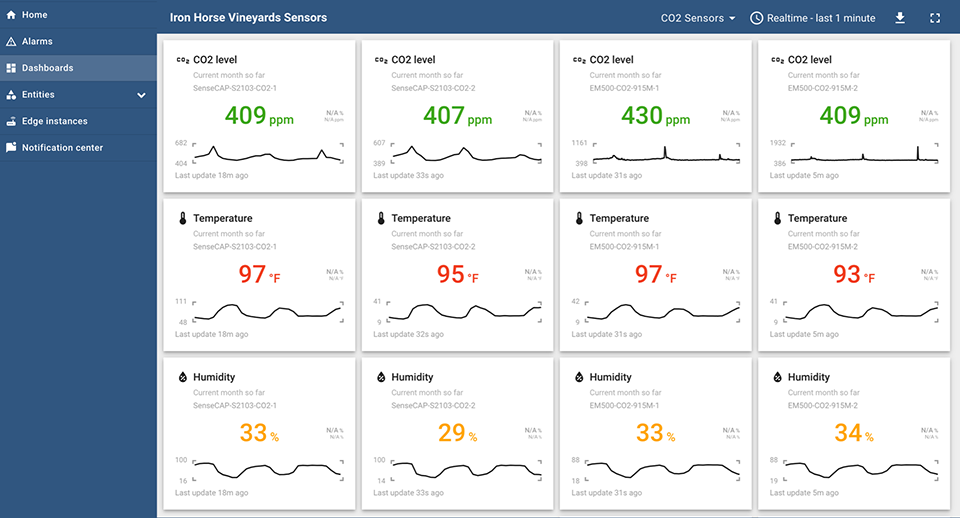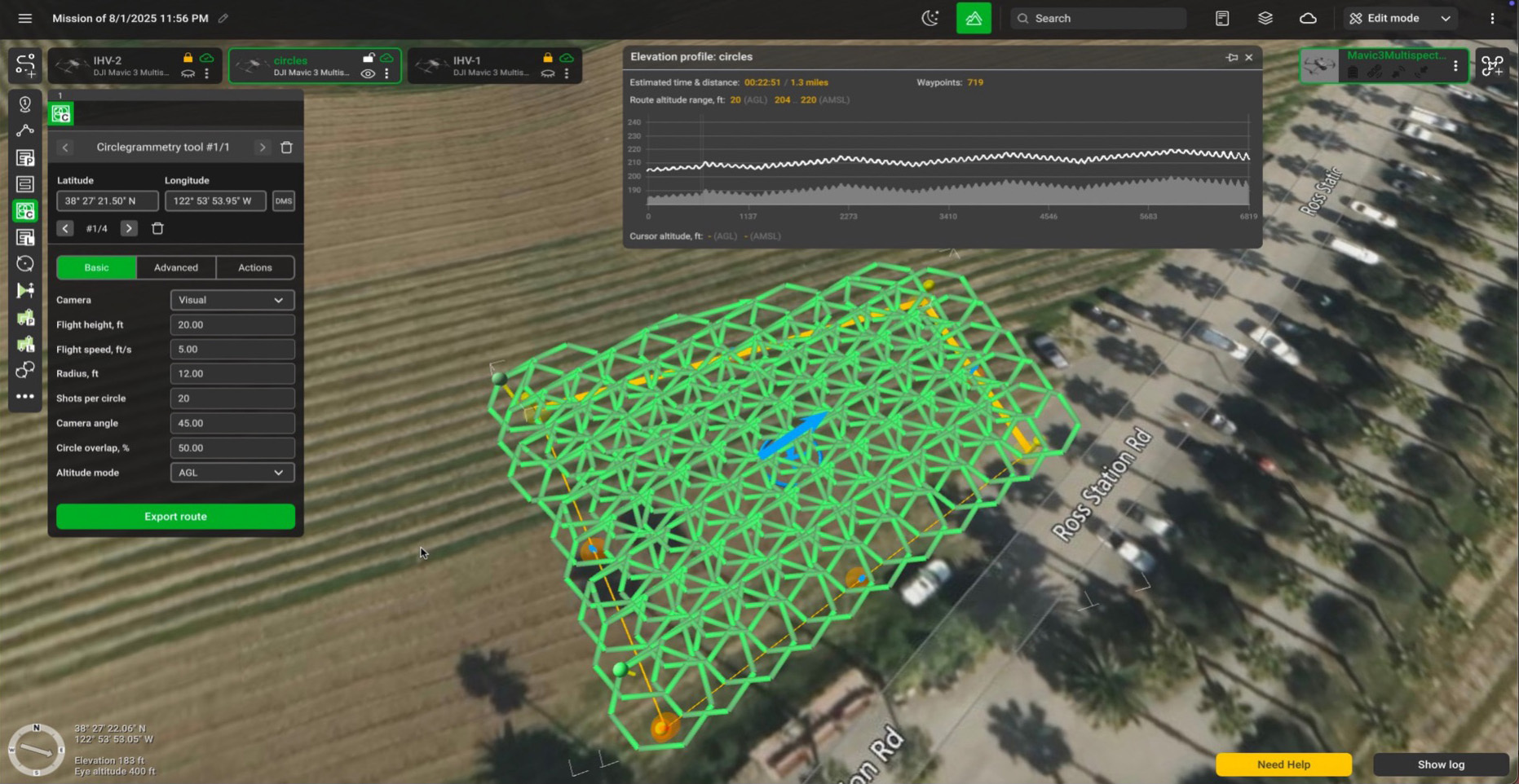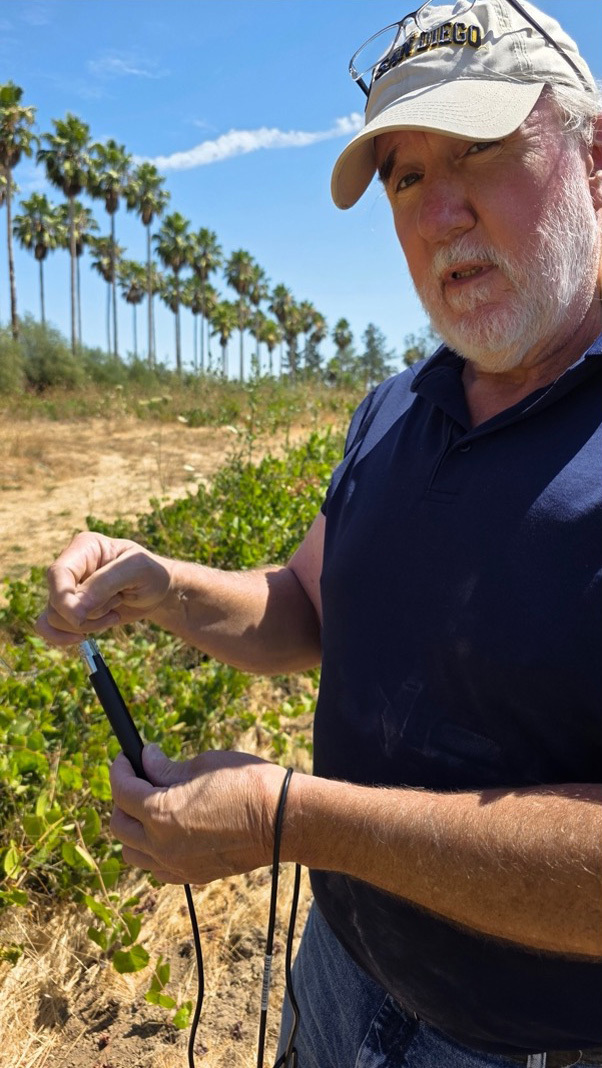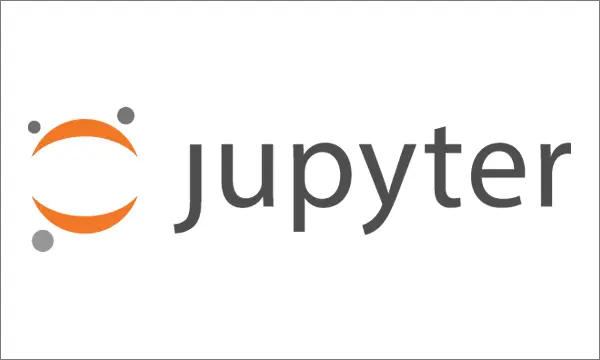- About
- Network
- Community
- Initiatives
- News
- Events
- Blog
- Publications

CENIC Members Enable Data-Driven Agriculture: Optimizing Harvests in a Changing Environment
Categories AI/Machine Learning Cultural & Scientific University of California Private Sector Technology & Innovation
When we imagine a family farm or a vineyard, we rarely think of the amount of digital data we can harvest from the growing plants, the soil, and even the air in the fields.
However, the potential and promise of all that information are drawing attention from researchers and leaders in the industry to the use of technology in agriculture. And this agricultural technology—now called precision agriculture—may prove to be just as transformative to farming as the tractor was in the late 1890s.
What if the soil in the remote and hilly terrain of a vineyard could regularly deliver data on its moisture and health? And what if quickly gathered data from every cluster of grapes could tell a vintner when it is time to harvest them? And what is the value of comparing all that data from year to year? Sensor technology linked to CENIC AIR makes all of that possible today. The challenge is to collate the disparate sources of data that emanate from a vineyard to provide continuous, actionable information.
That challenge is being addressed by an innovative demonstration project fueled by CENIC and its collaborative partners: a novel model of precision agriculture in the vineyards.
The project launched on the site of Iron Horse Vineyards, located near Sebastopol in California. Working with second-generation vineyards owner Joy Sterling, a leading proponent of broadband connectivity for the nation’s agricultural fields, CENIC is serving as the primary convenor of the varied expertise needed to realize this project.

Iron Horse, CENIC, and UC San Diego Creating Living Agricultural Laboratory
Sterling served on the Federal Communications Commission (FCC) task force for reviewing the connectivity and technology needs of precision agriculture in the United States, which delivered its final report at the end of 2024. She chaired the subgroup that examined the current and future demand for connectivity and delivered a succinct set of recommendations to serve the nation’s agricultural infrastructure.
“Agriculture today is a matter of national security,” said Sterling. “The need to deploy a growing array of technology solutions to ensure sustainability and resilience for our food production will serve to protect the output needed to feed our nation. And our ability to enable full traceability across the agricultural supply chain is key to ensuring food safety in the future.”
Iron Horse will serve as a test-bed living laboratory for agricultural research and education, working with CENIC, faculty and staff from UC San Diego and its San Diego Supercomputer Center (SDSC), UC Agriculture and Natural Resources (UC ANR), Sonoma State University, and Santa Rosa Junior College, as well as AT&T, Emergent, and other private entities. This project, first conceived in December 2024, will use the information provided by vines, soil, and air to improve the output and increase the sustainability of the vineyards.
Multiple technical milestones had to be achieved during 2025 for the project to transmit data, as it has begun to do. These include completion of a last-mile fiber connection to the vineyards; the testing and installation of a 10-Gigabit per second (Gbps) CENIC router at the Iron Horse computer room; the installation of the initial round of soil, temperature, fog/rain, and CO2 sensors; and in-flight drone and ground-level ebike ultra-high-resolution multi-spectral video capture.

Project Drives Reduction in Water Use, Improvements in Yield and Understanding
This living laboratory uses a range of sensors to measure air and soil temperature and moisture and soil acidity levels in the vineyards. Many of the sensors are connected via a low-power, wide-area network (LoRaWAN), which is ideal for large rural areas that require long-range transmissions on low power. LoRaWAN devices can operate for years on batteries and support a large number of Internet of Things devices, making them effective for agricultural use.
“We believe the readings from these sensors can be effective for monitoring quality issues in the vineyard,” said Sterling. “We hope to monitor water use, for example—both the amount and the timing of watering. When there’s too much water, it leads to overgrowth.”
Sterling noted a use case in the California Central Valley, where a 400-acre agricultural site was able to reduce its water use by 10 percent thanks to sensors in the field. This represents a significant savings in a state prone to drought.
A major ongoing goal is the creation of a virtual replica of the vineyards built through real-time data and used for study and testing purposes, known as a “digital twin.” Such a virtual replica might enable vintners to optimize yield and quality. For example, it’s not enough simply to place carbon dioxide, weather, or temperature monitors; one must also know where best to place them and what might cause anomalous readings. Carbon dioxide monitors meant to measure air in the fields might, if located too close to fermentation tanks, give inaccurate readings as the process of fermentation itself creates CO2. Similarly temperature, moisture, and general weather sensors could give an incorrect picture of the overall state of the vineyards if located too close to trees, equipment, or other sources of heat, cold, vibration, or moisture.

CENIC Brings Networking, Expertise, and the CENIC AI Resource
CENIC brings to the farm its ultra-high-bandwith, statewide, 8,000-mile California Research and Education Network (CalREN), connected to Iron Horse with a 10 Gbps this past June, in collaboration with AT&T.
CENIC’s connections also offer access to the expertise and R&D capabilities of its member California universities, where much of the nation’s AI innovation was born and currently resides. The CENIC AI Resource (CENIC AIR) taps into both the technical and human network of academic and industry relationships for this project. Key leaders are eager to see how the massive data collected from Iron Horse over time will identify valuable trends to support adaptations for changing climate conditions. CENIC’s Tom DeFanti has been contacting several California State Universities and California Community Colleges with viticulture and agriculture programs, many of which have their own vines and farms.

“One of the things you can potentially study with AI is how to lay out rows of vines and make decisions about placement,” said John Graham, senior research scientist with UCSD/SDSC shown at right holding a soil sensor. “AI can tease out non-obvious relationships between vine locations, watering, and growth to get the best outcomes for wine. For example, if there’s a drought, it can help inform whether to spray water and blow air or use drip irrigation. It could even figure out what kind of fish in the holding pond could create the ideal nutrient-rich water to blow on the plants.”
Keith Taylor, PhD, Associate Professor of Cooperative Extension and Community Economic Development at UC Davis, believes CENIC will play a critical role in ensuring the future durability and sustainability of farming in California. “Climate shifts are rapidly changing agriculture everywhere,” said Taylor. “We now need proper data—and comparative data—to adapt for the near future. And to achieve that goal, we need people like the experts at CENIC to both create and set the table so other telecoms or providers can join the table successfully.”
“We are grateful to all of our partners who are helping to create a living laboratory for data-driven agriculture, and particularly to Joy and the team at Iron Horse Vineyards,” said Louis Fox, CENIC’s CEO. “This effort will generate remarkable new opportunities for students to learn and for researchers and practitioners to contribute to national database platforms in sustainable agriculture. This is a first chapter in a larger initiative to create similar testbeds in other disciplines that will, similarly, focus on advancing state-of-the-art practices across critical fields and on providing pathways to new careers in AI-related fields for all Californians.”

Sharing Results and Engaging Global Agricultural Researchers
CENIC’s close relationships with US and global research networks, big-data initiatives, and students and researchers in California and beyond offer another advantage for Iron Horse as it seeks to engage beyond the traditional viticulture community. Sterling plans to make datasets openly available via the National Data Platform and engage the student and research populations of other CENIC member institutions via the creation of on-site labs as well as through CENIC AIR and the National Research Platform.
Progress will be presented at the upcoming CENIC biennial conference The Right Connection. Attendees meet with colleagues from all CENIC segments, enjoy engaging presentations and panels, share insights and opinions, discover opportunities for collaboration, and see live demonstrations of cutting-edge technology.
The next CENIC conference takes place from March 29 to April 1, 2026, in Monterey, CA. A Call for Proposals and early-bird registration will be announced in early fall.
Related blog posts
CENIC and San Diego Supercomputer Center Create Sustainable Agriculture for California’s Future
CENIC’s networking and services, including CENIC AIR, can be a vital part of preparing new generations of farmers that will apply the latest technology to agriculture by turning the farm into an educational setting and improving the efficiency of farming as a career.
Explore the Future with Jupyter Notebooks and CENIC AIR
Jupyter notebooks are key tools for various research and data science tasks, such as exploratory data analysis (EDA) and scientific analysis, and educational uses. CENIC members are in an ideal position to use Jupyter Notebooks with the CENIC AI Resource (CENIC AIR).


